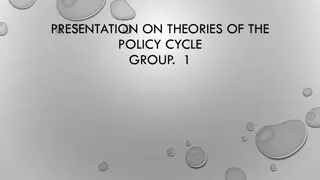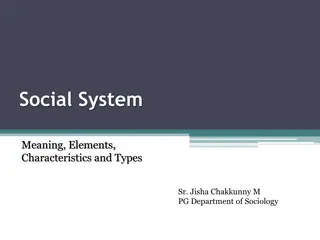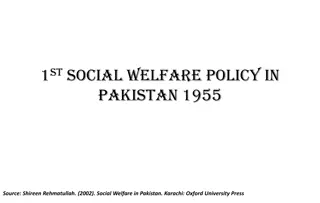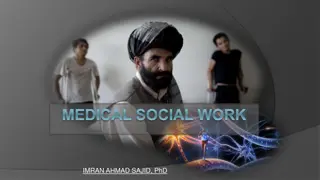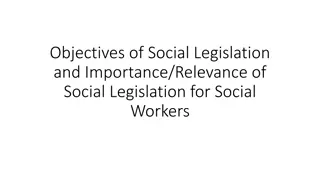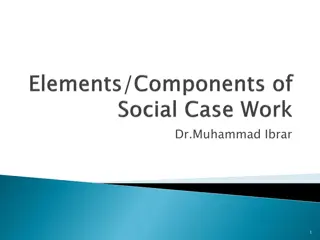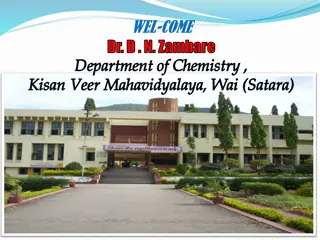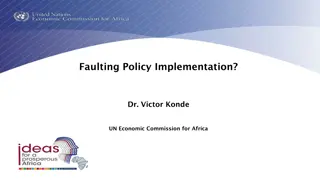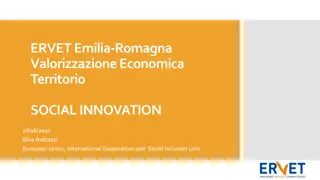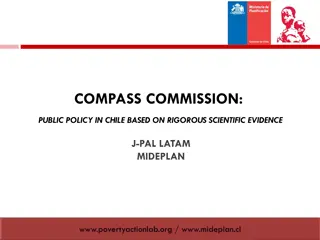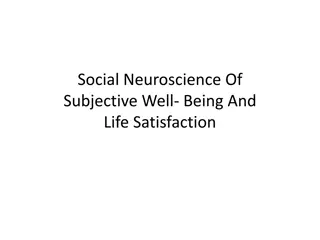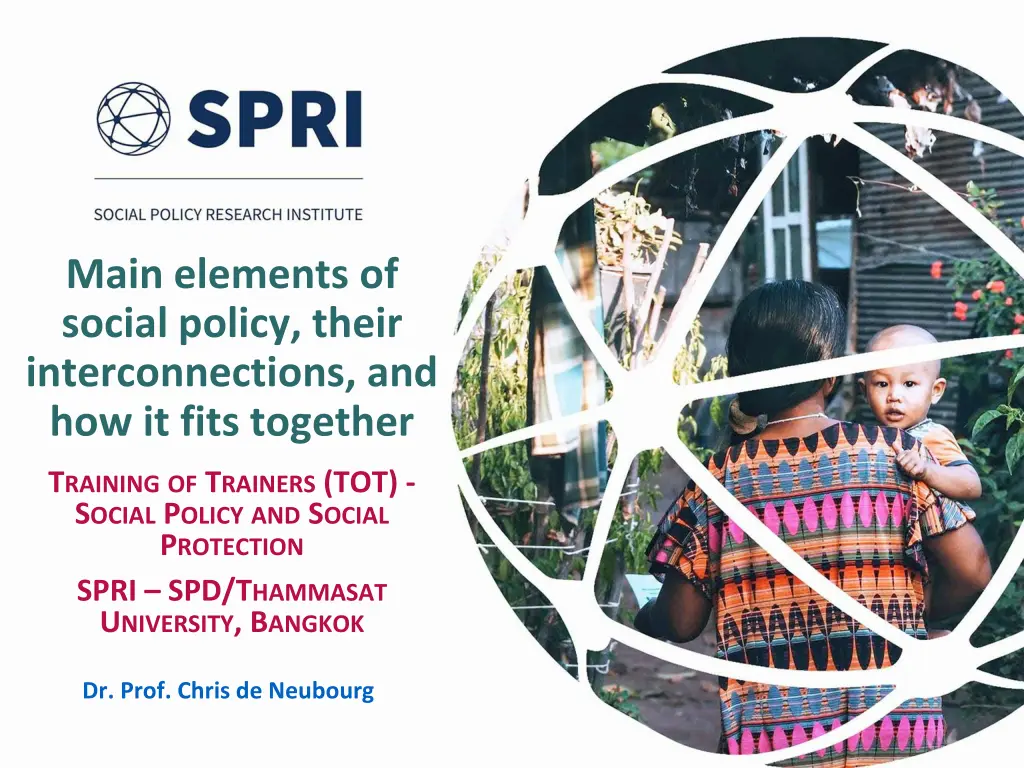
Understanding Social Policy, Social Protection, and Their Interconnections
Explore the main elements of social policy, its objectives, and how it relates to social protection. Delve into the instruments of social policy and the broader concept of social protection system. Discover the interconnected nature of social policy and protection beyond cash transfers.
Download Presentation

Please find below an Image/Link to download the presentation.
The content on the website is provided AS IS for your information and personal use only. It may not be sold, licensed, or shared on other websites without obtaining consent from the author. If you encounter any issues during the download, it is possible that the publisher has removed the file from their server.
You are allowed to download the files provided on this website for personal or commercial use, subject to the condition that they are used lawfully. All files are the property of their respective owners.
The content on the website is provided AS IS for your information and personal use only. It may not be sold, licensed, or shared on other websites without obtaining consent from the author.
E N D
Presentation Transcript
Main elements of social policy, their interconnections, and how it fits together TRAINING OF TRAINERS (TOT) - SOCIAL POLICY AND SOCIAL PROTECTION SPRI SPD/THAMMASAT UNIVERSITY, BANGKOK Dr. Prof. Chris de Neubourg
Social policy some questions ?? What is social policy? What are the objectives of social policy? What makes a good society? Who is responsible? Who should care about these things? Is social policy about poverty? Is social policy about inequality? Is social policy about economic growth? Is social policy the same as social protection?
Social Policy Social policy is about economic growth Making sure everybody makes good investments in human capital to ensure economic growth Social Policy is about reducing/alleviating poverty Making sure that everybody can survive in a decent way Social Policy is about reducing inequality Making sure that nobody is left behind
The main instruments of social policy Taxation Provision of basic social services: education, health, housing Provision of social- and labour laws that avoids exploitation, that avoids leaving people behind Provision of social transfers: contributory and non- contributory = Social Protection
Social Protection: some questions ?? What are the main elements of the social protection system in Bhutan? What are the main problems of the social protection system in Bhutan? Who benefits of social protection in Bhutan?
Social policy and protection are more than cash transfers: Social Protection System in Europe: the Life cycle framework UCA = Universal child allowance EA = Educational allowance ILI = Income loss insurance SA = Social Assistance CSP = Contributory survivors pension CP = Contributory pension UP = universal pension PP = private pension UCA, age 0 - 16 EA, age 16 - 24 ILI; SA; CSP, age 24 60+ UP; CP+CSP; PP; SA DA for people disabled from birth as well as for those who are permanently or temporarily disabled Investment in human capital/educational system Re-training, employment protection, minimum standards, wage Health, disasters, family protection, care facilities all age groups and handicapped
Social Protection is about having enough resources to survive During the life cycles there may be periods during which people do not have enough resources These risks are linked to Specific periods Specific events Crises Livelihood circumstances
Need for minimum resources for subsistence Y Ymin Yt age
Linked at investments in human capital over generations Y Ymin Yt age
welfare inequality Reproduction of Time
Subsistence at times of shocks Y Ymin Yt age
Acute problems of investment in own welfare or in human capital of children Y Ymin Yt age
The Welfare Pentagon Private Markets Social Private Families Social networks Public Social Protection Membership institutions Public authorities
The channels of the welfare pentagon are substitutes Gross and net public and private expenditures for social protection (including health care) as % of GDP
The channels of the welfare pentagon are substitutes Public and private social spending Sweden and the USA
Public Social Protection Contrary to private social protection, public social protection wants to be: predictable Regular relevant Linked to (human) rights and legal arrangements More effective due to risk sharing Not linked to family and social network privileges
Principal functions of Social Protection interventions Transformation: assisting families to overcome their vulnerabilities; no poverty traps Promotion: Helping families to reduce their risks and risk exposure Prevention: preventing adoption negative risk coping strategies Survival: help to overcome crisis
Main objective of social protection = - Changing the income distribution to eradicate poverty - Investing in human capital in order to change the productivity distribution
Welfare inequality Reproduction of Time
Social protection toolbox Social Transfers: in cash, in kind, in assistance, in vouchers Social Insurance: contributvef, risk sharing Health coverage, Old age pensions, Social Services Regulation and legislation
Social protection toolbox 2 For whom? Universal (or categoric) Targeted: for specific groups in function of the characteristics of the groups Conditionnal or not? Only provided to those people who respect certain behaviourial conditions (sending children to school, for health checks, participation in education, public works
Main principle of social protection SYSTEM Principle r 1 : taking life cycle into consideration Principle 2 : taking vulneranbilitym poverty,risk management and main objectives of social protection into consideration Principle 3 : Systemic approach
Main principle of social protection SYSTEM 2 Principle r 4 : pragmatic limitations and constraints Principle 5 : Human rights based Principle 6 : settings priorities but having a universalist goal Principle 7: paying attention to investments and long term effects
27 Conceptualization of social protection World Bank (2001): interventions that assist poor individuals, households and communities to reduce their vulnerability by managing risks better African Union (2008) SP include the pursuit of an integrated policy approach with a strong developmental focus, such as job creation, equitable and accessible health and other services, social welfare, quality education and so on (Government of Mali, 2002) a collective system (state or private) for managing risks (unemployment , old age, extreme or chronic poverty) faced by individuals
28 Conceptualizations of social protection Benin (2002) social protection comprises all systems and measures that provide social assistance and various social services to the different social and professional groups Tanzania (2008) traditional family and community support structures, and interventions by state and non- state actors that support individuals, households and communities to prevent, manage, and overcome the risks.
29 Social protection Social Protection ? All income transfers (or benefits) in kind and in cash that a society affords to its individual members in order to: avoid or alleviate poverty; or assist them in coping with a series of life contingencies or risks which, if they occurred, might otherwise lead to a loss of income (losing one s job, losing one s earnings capacity through invalidity or old age, having to obtain expensive medical care in the event of illness or impairment); or reduce or correct inequalities created through the primary (pre-transfer) income distribution.
30 A very general picture of SP
32 Concepts: Contingencies Contingencies: events that might or might not occur (having an accident or winning the lottery, for example).
33 Concepts: Risks Risks: contingencies that are perceived as having a negative effect on individuals, groups or societies or even more complex entities, such as the environment. 1. Sickness/Health care 2. Disability 3. Old age 4. Survivors 5. Family/children 6. Unemployment 7. Housing 8. Social exclusion not elsewhere classified.
34 Concepts: Risks Insurable risk: a certain risk with a known probability of occurrence (can be calculated) and with big potential damage. Risk exposure: You are exposed to a risk if a certain event can occur and affect you with a certain degree of probability
35 Concepts: Vulnerability Vulnerability: You are vulnerable to a certain risk if you have no means of coping with the consequences of that risk once it has occurred
36 Concepts: Social Security Social protection makes you less vulnerable to the financial consequences should the risks materialize. It provides some social security.
37 Social risk management The whole portfolio of strategies and arrangements ranging from risk reduction, avoidance or prevention to risk mitigation and risk coping, and consisting of informal arrangements of the individual or the family, market-based arrangements and public provisions (WB)
38 Social risk management sequence risk identification ? risk prevention or risk reduction ? risk mitigation ? risk coping
39 In the narrow definition used here, social protection is not concerned with the avoidance or reduction of risks Instead, it focuses on helping societies to organize the financing of the mechanisms that help people to mitigate or cope with risks.
40 Social protection in economic and financial terms Set of measures that a society employs to give its members some form of income security. Limited to measures that can be characterized as transfers of income (also known as benefits) in cash or in kind. Transfers can be formal or informal These measures necessarily have a profound impact on income distribution in the country
41 Insurance benefits as income transfers The difference between insurance benefits and universal unconditional transfers (benefits) or targeted means- tested transfers is simply the legal nature of entitlements (i.e. being entitled to benefits as a contributor, a resident, or a resident fulfilling a certain targeting condition, for example poverty) Also, this difference has cultural/values roots (a separate lecture is coming)
42 Social Protection through Social Transfers
43 Social transfers Social (income) transfers reallocate income both within and among households. Their purpose which is the other essential element in the definition of social protection as social transfers is to: guarantee a minimum level of consumption for people living in poverty or on the threshold of it, or replace wholly or in part income lost as a result of a certain contingency, or g achieve a higher level of income equality.
44 Social transfers Social transfers transform ethical norms into cash or in-kind income flows, which in turn are translated into (real) consumption levels. NB. It is not important the amount but what you can buy with that amount. A society can choose whether to redistribute income: formally (defined by law or contractual arrangements) Informally (defined on an ad hoc basis according to traditional or general legal obligations within family units)
45 In economic terms, formal and informal transfer systems substitute for each other! Shift from interfamily to government transfers, United States,%1935 80
46 Social transfers Societal values and norms dictate that people in need should receive a certain level of assistance. Societal preferences, experience and administrative capabilities then determine whether these transfers should be organized formally through established laws or whether they should be left to private initiative. If it has been decided to formalize a certain kind of transfer, then the scheme has to go through a filter of economic, fiscal and financial affordability as well as a filter of administrative deliverability.
Principal mechanics of the redistributive process Social protection transforms ethical norms into transfers 47
48 Transfer systems All transfer systems, whether formal or informal, have four components: financiers; rules governing entitlements; an organization operating redistributive flows and/or providers of goods and services; and Recipients In formal schemes, all these components must be defined by law or contractual arrangements In informal schemes, one, two, or all these components are defined adhoc based on traditions or family units
49 Informal transfers systems Informal intra-family and intra-community transfers can be broken down into a variety of different types: child transfers active-age transfers old-age transfers Developing countries have up to 80% of informal social transfer
50 Risks for Informal Transfers Family size Stability of the economic situation Harvest, weather. Reliance on family or community norms to receive help (dignity issue) migration (rural-urban; national, international) AIDS




